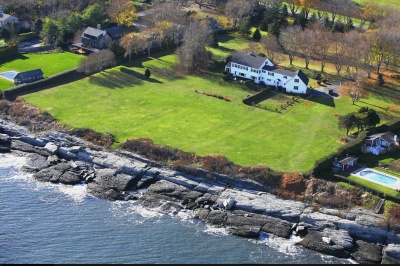 Know the Rules. Enjoy the Lifestyle.
Know the Rules. Enjoy the Lifestyle.Waterfront properties are life enhancing. They offer long, lazy days at the shore, your own lobster pots, idyllic family vacations, views to decompress the most frazzled executive and a rare, primal connection with nature. Like most rare and wonderful things, however, they come with their own set of unique challenges. So if you're looking for a waterfront home in Rhode Island, here are a few things to keep in mind.
1. COASTAL BUFFER ZONES - Although your property extends to the water's edge, Rhode Island's Coastal Resource Management Council has jurisdiction over the last 200 feet. This area is called the coastal buffer zone, and it is measured inland from the mean high tide mark. Improvements like docks, stairs, boathouses or walkways all require a detailed application and approval by CRMC. Once a permit is granted, construction can begin.
2. CLEARING & MAINTAINING THE BUFFER ZONE - Vegetation must be maintained according to strict regulations that prevent removal of established trees and plants in the buffer zone. You may also be required to plant native species (like blueberries and grasses) in this area. CRMC monitors the vegetation along the coast using satellite images to determine whether an area has been cleared or altered without permission. Violations can result in significant fines.
3. FLOOD CONCERNS & INSURANCE - Check to see whether your prospective home is in a flood zone. FEMA's website, includes flood maps indicating the likelihood of serious flooding in your area. New construction must be sited above the flood elevation, and more hazardous zones require flood insurance. To obtain flood insurance, you will need an elevation certificate. An elevation certificate measures the difference in elevation between your home and the base flood elevation of your area. It is normally prepared by a licensed engineer, and it is required in order to calculate the risk for your location and the rate for your policy. Because FEMA adjusts its flood zones from time to time, don't depend on the seller's certificate which may be out of date. Also, make sure to check with your insurer to see when your flood insurance policy will take effect. Be aware that cash transactions (no bank involved) trigger a 30-day waiting period from the time your policy is approved to the time it actually takes effect.
4. MAINTAINING A HOME BY THE WATER - Salt air is hard on most metals and some paint. Check the hardware and exterior materials on the home to make sure it can stand up to the punishment that wind and weather inflict on coastal properties.
5. DOCKS - Don't assume you can build a dock. Docks are often approved after CRMC review, however, a detailed application with engineers' drawings is required, and permission depends on a variety of factors including the water classification in the area. You can learn more about specific water classifications and their respective restrictions at CRMC’s Water Use page. Also, take a look at this post: Can I Build a Dock om My Water Front Property?
6. SEPTIC SYSTEMS - If you're buying waterfront land in an area without a municipal sewer system, be sure the property has an approved septic design. Alternatively, make your offer subject to septic design approval for a specific number of bedrooms. Septic designs are prepared by engineers and submitted to Rhode Island's Department of Environmental Management for approval. If the septic system is in or near the coastal buffer zone, you will need CRMC approval as well before installing or replacing a system. The capacity of the septic system will determine the number of bedrooms you can build.
7. WELLS – In areas where municipal water is not available, make sure there is a well with potable water, and be aware that wells must be located at least 200 feet from your septic system AND 200 feet from your neighbors’ septic systems. Contact the Department of Environmental Management and Coastal Resources Management Council to review all state regulations that apply.
8. VIEW PROTECTION - Homeowners have no inherent right to a view. Make sure your view won't be compromised by a new or expanded home in your site line. Look carefully at the trees in the neighborhood to see whether they could block your view as they grow. Find out about the neighbors’ feelings about view protection. Look at the deeds of the properties in your site line to see whether any view easements exist.
9. PROTECTIVE COVENANTS & ASSOCIATION DOCUMENTS - In Rhode Island protective covenants are usually put in place by developers or previous owners to insure that the actions of one owner do not adversely effect the others. Be aware that protective covenants can expire. If the area you are considering has protective covenants, ask a RI attorney review them to determine how long they have been in effect and when they expire. Read association documents to learn about private restrictions or easements that may affect your use of the property. Association rules and regulations are created and enforced by association boards and committees.
10. PUBLIC RIGHTS OF ACCESS – Check to see whether the public has the right to cross your property to access the water. Check municipal plat maps and CRMC public access maps to determine whether there is a public way on or near your waterfront property.
If all these things seem manageable, you can start your waterfront home search here. Once you settle on "The One," negotiate that deal, and start enjoying all the wonderful benefits of life by the sea in Rhode Island.

Leave A Comment